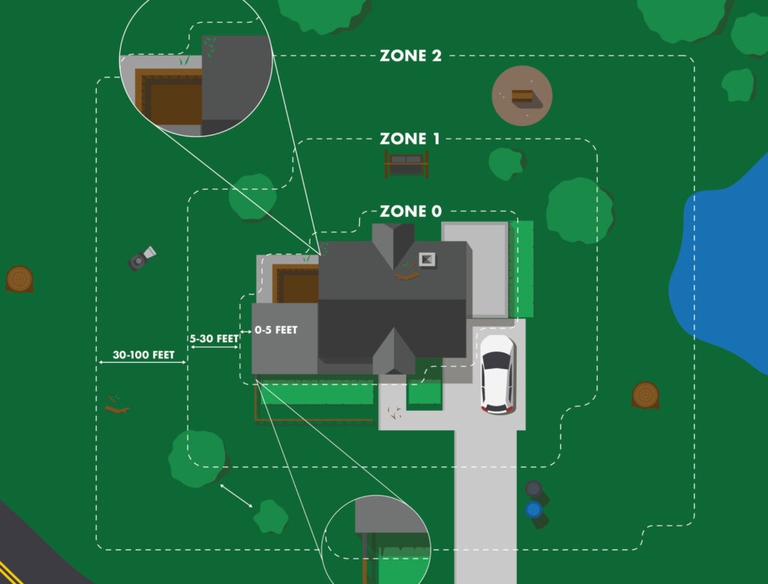Wildfire Prevention
Defensible Space Zones
Three zones make up the required 100 feet of defensible space (explained below). Defensible space is the buffer space created by removing vegetation, which is also the first level of defense against wildfires. Home hardening is using construction materials that can help your home withstand flying embers, and decrease the spread of fire. Specific recommendations for each zone are described below, followed by home hardening tips.

Zone 0: Immediate Zone
Zone 0 extends 5 feet from buildings, structures, decks, etc. it is key for wildfire defense and preventing fires from spreading to your home:
- Use gravel, pavers, or concrete instead of combustible mulch
- Clear dead weeds, grass, and debris; check roofs, gutters, and outdoor areas
- Keep branches trimmed 10 feet away from chimneys and stovepipes
- Minimize combustible items like furniture and planters on decks
- Replace combustible fencing and gates with fire-resistant materials
- Shift garbage and recycling containers to a safer area outside this zone
- Relocate boats, RVs, and vehicles away from this zone to reduce fire risks
Zone 1: Intermediate Zone
Zone 1 extends 30 feet out from buildings, structures, decks, etc.
- Remove all dead plants, grass, and weeds (vegetation).
- Remove dead or dry leaves and pine needles from your yard, roof, and rain gutters.
- Trim trees regularly to keep branches a minimum of 10 feet from other trees.
- Remove branches that hang over your roof and keep dead branches 10 feet away from your chimney.
- Relocate wood piles into Zone 2.
- Remove or prune flammable plants and shrubs near windows.
- Remove vegetation and items that could catch fire from around and under decks.
- Create a separation between trees, shrubs, and items that could catch fire, such as patio furniture, wood piles, swing sets, etc.
Zone 2: Extended Zone
Zone 2 extends from 30 feet to 100 feet from buildings, structures, decks, etc... or to the property line, whichever is closer.
- Remove all dead plants, grass, and weeds (vegetation).
- Create horizontal spacing between shrubs and trees
- Create vertical spacing between grass, shrubs, and trees.
- Trees 30–60 feet from the home should have at least 12 feet between canopy tops
- Trees 60–100 feet from the home should have at least 6 feet between canopy tops
- Trim annual grass down to a maximum height of 4 inches.
- Remove any debris, leaves, needles, pines, twigs, and small branches
Home Hardening
Flying embers destroy homes up to two miles away from wildland areas. Home hardening techniques can help reduce the risk of wildfires.
Roofs & Walls
- Build your roof or re-roof with Class A fire-resistant materials such as composition, metal, or tile.
- Block any spaces between roof decking and covering to prevent embers from catching fire.
- Use fire-rated calking to seal siding gaps.
- Use fire-resistant material building materials (brick, fiber cement, and stucco) for walls.
- Maintain a 5-foot noncombustible zone around the home.
Vents & Rain Gutters
- Cover all vent openings with 1/8-inch metal mesh.
- Do not use plastic or fiberglass mesh, since it tends to melt.
- Screen or enclose rain gutters to prevent the accumulation of plant debris, but have the ability to access them to clean out every few years.
Windows & Doors
- Choose dual-paned windows with at least one pane of tempered glass to decrease the risk of shattering and reduce heat.
- Use metal doors instead of wood.
- Seal any gaps around doors to prevent ember entry.
Patios & Decks
- Patio covers should be durable and made of fire-resistant material.
- Decks should be kept clean and free from debris that can ignite.
- Before leaving on vacation, remove all furniture from decks and place them away from the home.
Additional Links/Resources:
- Firewise Communities
- Be Ready for Wildfires
- Wildfire Know Your Zone
- Firewise USA
- Fire Safe San Mateo County
- Calfire Defensible Space Information
The information contained on this page is derived from several print and online sources:
- University of California Publication 8228. Home Landscaping for Fire. 2007. University of California, Davis.
- http://www.readyforwildfire.org/ Wildfire is Coming: Are You Ready. CAL FIRE. 2012.
- Urban Forestry Associates. Ray Moritz, Urban Forester and Fire Ecologist.
- https://firesafesanmateo.org/ Fire Safe San Mateo County. 2012.
